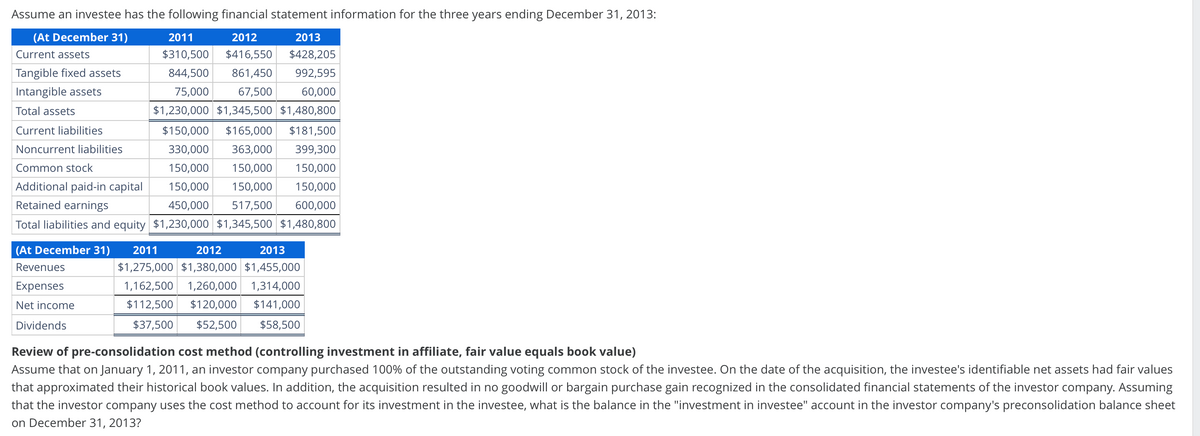Assume an investee has the following financial statement information for the three years ending December 31, 2013: (At December 31) 2012 2013 2011 $310,500 $416,550 $428,205 844,500 861,450 992,595 67,500 60,000 75,000 $1,230,000 $1,345,500 $1,480,800 $150,000 $165,000 $181,500 330,000 363,000 399,300 150,000 150,000 150,000 150,000 150,000 150,000 450,000 517,500 600,000 Total liabilities and equity $1,230,000 $1,345,500 $1,480,800 (At December 31) Revenues Expenses Net income Dividends Current assets Tangible fixed assets Intangible assets Total assets Current liabilities Noncurrent liabilities Common stock Additional paid-in capital Retained earnings 2012 2013 2011 $1,275,000 $1,380,000 $1,455,000 1,162,500 1,260,000 1,314,000 $112,500 $120,000 $141,000 $37,500 $52,500 $58,500 Review of pre-consolidation cost method (controlling investment in affiliate, fair value equals book value) Assume that on January 1, 2011, an investor company purchased 100% of the outstanding voting common stock of the investee. On the date of the acquisition, the investee's identifiable net assets had fair values that approximated their historical book values. In addition, the acquisition resulted in no goodwill or bargain purchase gain recognized in the consolidated financial statements of the investor company. Assuming that the investor company uses the cost method to account for its investment in the investee, what is the balance in the "investment in investee" account in the investor company's preconsolidation balance sheet on December 31, 2013?
Reporting Cash Flows
Reporting of cash flows means a statement of cash flow which is a financial statement. A cash flow statement is prepared by gathering all the data regarding inflows and outflows of a company. The cash flow statement includes cash inflows and outflows from various activities such as operating, financing, and investment. Reporting this statement is important because it is the main financial statement of the company.
Balance Sheet
A balance sheet is an integral part of the set of financial statements of an organization that reports the assets, liabilities, equity (shareholding) capital, other short and long-term debts, along with other related items. A balance sheet is one of the most critical measures of the financial performance and position of the company, and as the name suggests, the statement must balance the assets against the liabilities and equity. The assets are what the company owns, and the liabilities represent what the company owes. Equity represents the amount invested in the business, either by the promoters of the company or by external shareholders. The total assets must match total liabilities plus equity.
Financial Statements
Financial statements are written records of an organization which provide a true and real picture of business activities. It shows the financial position and the operating performance of the company. It is prepared at the end of every financial cycle. It includes three main components that are balance sheet, income statement and cash flow statement.
Owner's Capital
Before we begin to understand what Owner’s capital is and what Equity financing is to an organization, it is important to understand some basic accounting terminologies. A double-entry bookkeeping system Normal account balances are those which are expected to have either a debit balance or a credit balance, depending on the nature of the account. An asset account will have a debit balance as normal balance because an asset is a debit account. Similarly, a liability account will have the normal balance as a credit balance because it is amount owed, representing a credit account. Equity is also said to have a credit balance as its normal balance. However, sometimes the normal balances may be reversed, often due to incorrect journal or posting entries or other accounting/ clerical errors.


Trending now
This is a popular solution!
Step by step
Solved in 3 steps







